
Euphorbia is a very large and diverse genus of flowering plants, commonly called spurge, in the family Euphorbiaceae. "Euphorbia" is sometimes used in ordinary English to collectively refer to all members of Euphorbiaceae, not just to members of the genus.

Euphorbia heterophylla, also known under the common names of Mexican fireplant, painted euphorbia, Japanese poinsettia, paintedleaf, painted spurge and milkweed, is a plant belonging to the Euphorbiaceae or spurge family.
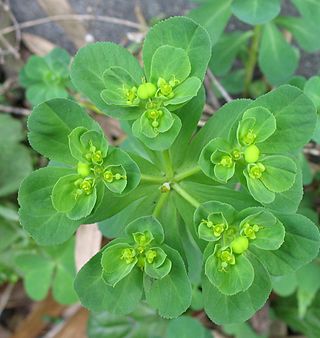
Euphorbia helioscopia, the sun spurge or madwoman's milk, is a species of flowering plant in the spurge family Euphorbiaceae. It is a herbaceous annual plant, native to most of Europe, northern Africa, and eastward through most of Asia.

Euphorbia cyparissias, the cypress spurge, is a species of plant in the genus Euphorbia. It is native to Europe and was introduced to North America in the 1860s as an ornamental plant.

Euphorbia myrsinites, the myrtle spurge, blue spurge, or broad-leaved glaucous-spurge, is a succulent species of flowering plant in the spurge family Euphorbiaceae.
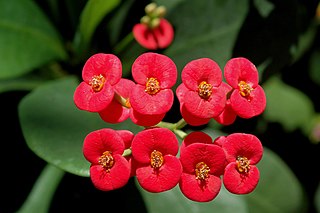
Euphorbia milii, the crown of thorns, Christ plant, or Christ's thorn, is a species of flowering plant in the spurge family Euphorbiaceae, native to Madagascar. The species name commemorates Baron Milius, once Governor of Réunion, who introduced the species to France in 1821.

Euphorbia resinifera, the resin spurge, is a species of spurge native to Morocco, where it occurs on the slopes of the Atlas Mountains. The dried latex of the plant was used in ancient medicine. It contains resiniferatoxin, an extremely potent capsaicin analog tested as an analgesic since 1997.

Euphorbia albomarginata, whitemargin sandmat or rattlesnake weed, is a small low-growing perennial, in the spurge family native to desert, chaparral, and grassland habitats of southwestern North America, from southern and central California to Northern Mexico and Louisiana.
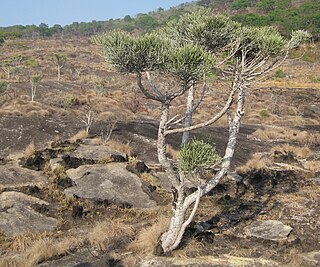
Euphorbia tirucalli is a tree native to Africa that grows in semi-arid tropical climates. A hydrocarbon plant, it produces a poisonous latex that can cause temporary blindness.

Euphorbia lathyris, the caper spurge or paper spurge, is a species of spurge native to southern Europe, northwest Africa, and eastward through southwest Asia to western China.

Euphorbia horrida, the African milk barrel, is a species of flowering plant in the family Euphorbiaceae, native to South Africa. It is a cactus-like shrub showing remarkable similarities to the true cacti of the New World, and thus an example of convergent evolution. Growing to 1.5 m, it has blue-green, heavily ridged spiny stems carrying solitary green flowers in summer. In temperate regions it must be grown in heated conditions under glass.

Euphorbia serrata is a species of spurge known by the common names serrated spurge and sawtooth spurge, and also known as Tintern spurge and upright spurge. It is native to Europe but it is present elsewhere as a weedy introduced species. This is a perennial herb growing anywhere from 20 centimetres to about half a metre in height. The leaves are long and very narrow on most of the plant, with more oval-shaped leaves toward the tips of the stems. They are finely toothed. At the ends of the branches are inflorescences of tiny flowers. The fruit is a spherical capsule about half a centimetre wide containing tiny gray seeds.

Euphorbia canariensis, commonly known as the Canary Island spurge, Hercules club or in Spanish cardón, is a succulent member of the genus Euphorbia and family Euphorbiaceae endemic to the Canary Islands. It is the plant symbol of the island of Gran Canaria.

Euphorbiaceae, the spurge family, is a large family of flowering plants. In English, they are also commonly called euphorbias, which is also the name of the type genus of the family. Most spurges, such as Euphorbia paralias, are herbs, but some, especially in the tropics, are shrubs or trees, such as Hevea brasiliensis. Some, such as Euphorbia canariensis, are succulent and resemble cacti because of convergent evolution. This family has a cosmopolitan global distribution. The greatest diversity of species is in the tropics; however, the Euphorbiaceae also have many species in nontropical areas of all continents except Antarctica.
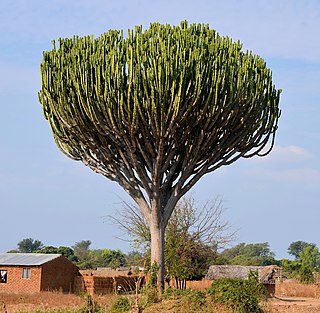
Euphorbia ingens is a species of flowering plant in the family Euphorbiaceae. It is native to dry areas of southern Africa. It is popularly known as the candelabra tree or naboom. Its milky latex can be extremely poisonous and is a dangerous irritant.

Euphorbia balsamifera is a flowering plant in the spurge family Euphorbiaceae. It is distributed in the Canary Islands and the western Sahara. It is the vegetable symbol of the island of Lanzarote. Euphorbia adenensis has been treated as a subspecies of this species.
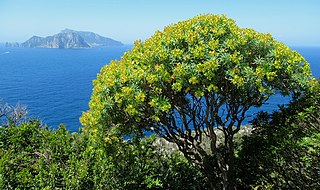
Euphorbia dendroides, also known as tree spurge, is a small tree or large shrub of the family Euphorbiaceae that grows in semi-arid and mediterranean climates.
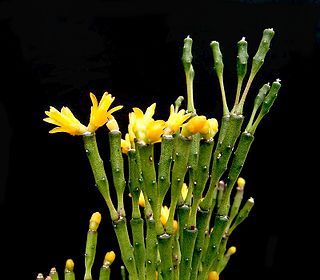
Hatiora salicornioides, the bottle cactus, dancing-bones, drunkard's-dream, or spice cactus, is a species of flowering plant in the cactus family. A member of the tribe Rhipsalideae, it often grows as an epiphyte, natively in eastern Brazil and ornamentally elsewhere.

Euphorbia cotinifolia is a broadleaf red shrub native to Mexico and South America. Treated as a shrub, it reaches 10 to 15 ft but can be grown as a tree reaching 30 ft (9.1 m). Small white flowers with creamy bracts bloom at the ends of the branches in summer. The purplish stems, when broken, exude a sap that is a skin irritant.
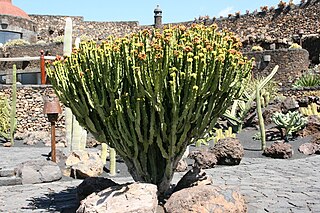
Euphorbia abyssinica, commonly known as the desert candle or candelabra spurge, is a species of plant in the family Euphorbiaceae. E. abyssinica is endemic to Ethiopia, Somalia, Sudan and Eritrea. It was first described in 1791, by the German botanist Johann Friedrich Gmelin. In its native habitat, it can grow up to 10 m (33 ft) tall. The woody stem is used for firewood and as timber in roofing, furniture and other items, and the sap is used in traditional medicine. It is also cultivated as an ornamental house plant.























